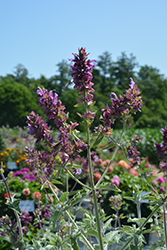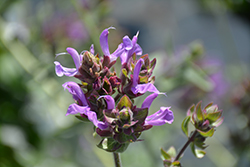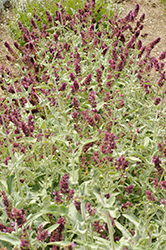Fri & Sat 8am - 8pm
Sun 8am - 7pm
Anytown, USA 12345
fax: 261.787.0463
e-mail: info@successgc.com


Plant Finder

Lancelot Canary Island Sage
Salvia canariensis 'Lancelot'
Height: 4 feet
Spacing: 24 inches
Sunlight:
![]()
Hardiness Zone: 7b
Other Names: Lancelot Salvia
Description:
An interesting cultivar featuring silvery white, felted leaves; lavender blooms from rose-burgundy calyces in summer that persist until fall; a beautiful addition to borders or containers with its dense, upright form; excellent for a dry, sunny area
Ornamental Features
Lancelot Canary Island Sage has masses of beautiful spikes of lavender flowers with pink overtones and rose calyces rising above the foliage from early summer to mid fall, which are most effective when planted in groupings. The flowers are excellent for cutting. Its attractive tomentose narrow leaves remain grayish green in color with curious white undersides and tinges of silver throughout the season. The burgundy stems are very colorful and add to the overall interest of the plant.
Landscape Attributes
Lancelot Canary Island Sage is an herbaceous perennial with an upright spreading habit of growth. Its relatively fine texture sets it apart from other garden plants with less refined foliage.
This is a relatively low maintenance plant, and is best cleaned up in early spring before it resumes active growth for the season. It is a good choice for attracting bees, butterflies and hummingbirds to your yard, but is not particularly attractive to deer who tend to leave it alone in favor of tastier treats. It has no significant negative characteristics.
Lancelot Canary Island Sage is recommended for the following landscape applications;
- Mass Planting
- Border Edging
- General Garden Use
- Groundcover
- Container Planting
Planting & Growing
Lancelot Canary Island Sage will grow to be about 3 feet tall at maturity, with a spread of 30 inches. When grown in masses or used as a bedding plant, individual plants should be spaced approximately 24 inches apart. It grows at a medium rate, and under ideal conditions can be expected to live for approximately 5 years. As an herbaceous perennial, this plant will usually die back to the crown each winter, and will regrow from the base each spring. Be careful not to disturb the crown in late winter when it may not be readily seen!
This plant should only be grown in full sunlight. It prefers to grow in average to dry locations, and dislikes excessive moisture. To help this plant achive its best flowering performance, periodically apply a flower-boosting fertilizer from early spring through into the active growing season. It is not particular as to soil type or pH. It is somewhat tolerant of urban pollution. This is a selected variety of a species not originally from North America. It can be propagated by division; however, as a cultivated variety, be aware that it may be subject to certain restrictions or prohibitions on propagation.
Lancelot Canary Island Sage is a fine choice for the garden, but it is also a good selection for planting in outdoor pots and containers. With its upright habit of growth, it is best suited for use as a 'thriller' in the 'spiller-thriller-filler' container combination; plant it near the center of the pot, surrounded by smaller plants and those that spill over the edges. It is even sizeable enough that it can be grown alone in a suitable container. Note that when growing plants in outdoor containers and baskets, they may require more frequent waterings than they would in the yard or garden.


